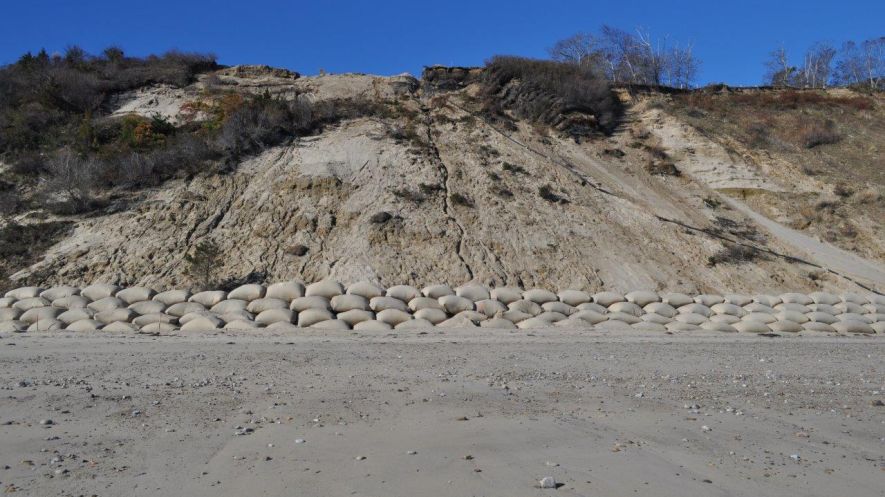NETCO Coastal Construction is pioneering the use of a “first in the United States” erosion solution for the White Cliffs Community Association (WCCA) in Plymouth MA.
NETCO is utilizing a shoreline protection system from Australia called ELCOROCK, that utilizes 7 ton geotextile containers (or geo-synthetic bags) filled with sand. These containers are then placed at the toe of the coastal bank to form a stable, durable shoreline protection system. NETCO is working for the White Cliffs Community Association to stabilize and rebuild a 300 feet long area of shoreline bank that is eroding, and which is located below a group of condominiums and the 18th tee box of the WCCA golf course.
The ELCOROCK system is considered by many to be a soft erosion control system. Increasingly, soft erosion control systems are replacing the previously-used “hard engineering structures”, which included concrete retaining walls, steel sheet pile walls and rock revetments. Changes in regulatory thinking at the local, state and federal levels has moved coastal bank shoreline protection and stabilization treatments away from hard structures due to increased wave reflection that such structures have on the beach. The concern is that hard engineering structures increase wave reflection which in turn accelerate the rate of erosion of the beach.
The newer “soft” coastal zone protection methods offer a way of protecting the shoreline that reduces the potential for erosion of the beach face in front of coastal protection structures. Soft erosion control measures are primarily designed to allow natural coastal erosion processes to continue while still allowing some protection of private and public property.
The geo-synthetic bags, which are a “soft solution,” absorb water during the up-rush of incoming waves and surf and are filled with beach-compatible sand. The 2.5 meter/7 ton containers are tan colored with a natural look, filled with beach compatible sand, permeable to absorb the uprush of storm and surf, and as part of the treatment indigenous grasses and shrubs are planted to grow over the containers and provide a completely natural look to the installation. The smaller size containers are also constructed in a terrace fashion to create a slope revetment face which is better able to absorb the uprush of waves and surf. The containers are also largely vandal proof.
Australia has been using the ElcoRock system for 20 + years. The smaller containers are considered in most applications to be superior to large “mega” geo bag containers in that they are installed in a terrace fashion which reduces wave reflection potential and reduces the cost of repairs.
At White Cliffs, NETCO has installed a 4 level terrace (12 feet of vertical elevation) built from the geo-bags, that is calculated at the top elevation to be above the 100 year flood or storm level. The installation is designed to withstand erosion from the ocean waves and against rain and run off. The geo-bags are heavy enough to withstand hurricane and nor’easter storm forces. The White Cliffs project is projected for completion this spring with the planting of the vegetation on the face of the 140 foot high coastal bank.
“We are pleased to bring this proven shoreline erosion solution to our U.S. shores,” said David Lager, President and Founder of NETCO. “White Cliffs is a stunning shoreline and the ELCOROCK system offers protection from the continuous erosion while reducing the impact of wave reflection on the beach face. We look forward to utilizing this erosion system along the Eastern seaboard.”
For more information, click here.





